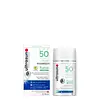What's inside
What's inside
 Key Ingredients
Key Ingredients

 Benefits
Benefits

 Concerns
Concerns

 Ingredients Side-by-side
Ingredients Side-by-side

Butyl Methoxydibenzoylmethane 2.8%
UV AbsorberHomosalate 9.6%
Skin ConditioningEthylhexyl Salicylate 4.8%
UV AbsorberOctocrylene 9.6%
UV AbsorberWater
Skin ConditioningGlycerin
HumectantButylene Glycol
HumectantPentylene Glycol
Skin ConditioningC12-15 Alkyl Benzoate
AntimicrobialSilica
AbrasiveDimethicone
EmollientHydrogenated Lecithin
EmulsifyingParfum
MaskingDimethicone/Vinyl Dimethicone Crosspolymer
Skin ConditioningXanthan Gum
EmulsifyingHydroxyethyl Acrylate/Sodium Acryloyldimethyl Taurate Copolymer
Emulsion StabilisingSodium Carbomer
Emulsion StabilisingIsohexadecane
EmollientPolysorbate 60
EmulsifyingSorbitan Isostearate
EmulsifyingDiethylhexyl Syringylidenemalonate
Skin ProtectingAminomethyl Propanol
BufferingCitric Acid
BufferingBenzyl Alcohol
PerfumingPotassium Sorbate
PreservativeSodium Benzoate
MaskingCitral
PerfumingLimonene
PerfumingLinalool
PerfumingCI 77891
Cosmetic ColorantButyl Methoxydibenzoylmethane 2.8%, Homosalate 9.6%, Ethylhexyl Salicylate 4.8%, Octocrylene 9.6%, Water, Glycerin, Butylene Glycol, Pentylene Glycol, C12-15 Alkyl Benzoate, Silica, Dimethicone, Hydrogenated Lecithin, Parfum, Dimethicone/Vinyl Dimethicone Crosspolymer, Xanthan Gum, Hydroxyethyl Acrylate/Sodium Acryloyldimethyl Taurate Copolymer, Sodium Carbomer, Isohexadecane, Polysorbate 60, Sorbitan Isostearate, Diethylhexyl Syringylidenemalonate, Aminomethyl Propanol, Citric Acid, Benzyl Alcohol, Potassium Sorbate, Sodium Benzoate, Citral, Limonene, Linalool, CI 77891
Water
Skin ConditioningZinc Oxide
Cosmetic ColorantDicaprylyl Ether
EmollientCoconut Alkanes
EmollientAlcohol
AntimicrobialPolyglyceryl-4 Diisostearate/Polyhydroxystearate/Sebacate
EmulsifyingCocos Nucifera Oil
MaskingSilica
AbrasiveTitanium Dioxide
Cosmetic ColorantPolyglyceryl-2 Dipolyhydroxystearate
Skin ConditioningUndecane
EmollientPolyhydroxystearic Acid
EmulsifyingCoco-Caprylate/Caprate
EmollientTridecane
PerfumingMagnesium Sulfate
Hectorite
AbsorbentEctoin
Skin ConditioningZinc Stearate
Cosmetic ColorantMaltodextrin
AbsorbentPotassium Cetyl Phosphate
EmulsifyingTocopherol
AntioxidantCaesalpinia Spinosa Fruit Pod Extract
Helianthus Annuus Sprout Extract
Skin ConditioningHelianthus Annuus Seed Oil
EmollientWater, Zinc Oxide, Dicaprylyl Ether, Coconut Alkanes, Alcohol, Polyglyceryl-4 Diisostearate/Polyhydroxystearate/Sebacate, Cocos Nucifera Oil, Silica, Titanium Dioxide, Polyglyceryl-2 Dipolyhydroxystearate, Undecane, Polyhydroxystearic Acid, Coco-Caprylate/Caprate, Tridecane, Magnesium Sulfate, Hectorite, Ectoin, Zinc Stearate, Maltodextrin, Potassium Cetyl Phosphate, Tocopherol, Caesalpinia Spinosa Fruit Pod Extract, Helianthus Annuus Sprout Extract, Helianthus Annuus Seed Oil
Ingredients Explained
These ingredients are found in both products.
Ingredients higher up in an ingredient list are typically present in a larger amount.
Silica, also known as silicon dioxide, is a naturally occurring mineral. It is used as a fine, spherical, and porous powder in cosmetics.
Though it has exfoliant properties, the function of silica varies depending on the product.
The unique structure of silica enhances the spreadability and adds smoothness, making it a great texture enhancer.
It is also used as an active carrier, emulsifier, and mattifier due to its ability to absorb excess oil.
In some products, tiny microneedles called spicules are made from silica or hydrolyzed sponge. When you rub them in, they lightly polish away dead skin layers and enhance the penetration of active ingredients.
Learn more about SilicaWater. It's the most common cosmetic ingredient of all. You'll usually see it at the top of ingredient lists, meaning that it makes up the largest part of the product.
So why is it so popular? Water most often acts as a solvent - this means that it helps dissolve other ingredients into the formulation.
You'll also recognize water as that liquid we all need to stay alive. If you see this, drink a glass of water. Stay hydrated!
Learn more about Water